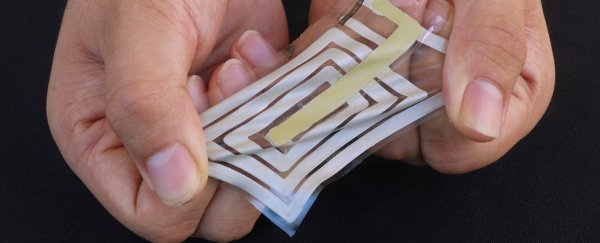As wearable technology grows ever more delicate and minute, some medical gadgets are on the brink of merging seamlessly with our skin. Researchers at Stanford University have now created a flexible electronic sticker that can wirelessly monitor a person's pulse, respiration and muscle activity at the same time.
A recent description of the unique system, known as the BodyNet, claims the soft and lightweight sensors merge comfortably with the skin, stretching and flexing imperceptibly with each movement, heartbeat or breath.
These precise wireless measurements are then beamed from the sticker to a nearby flexible receiver, clipped somewhere onto a person's clothing.
So far, the technology has only been demonstrated on one individual, and the receiver is still a bit clunky, as you can see in the image below.
But after three years of work, the team plans to refine their design even further. In the future, they hope physicians can use the device to track sleep disorders and heart conditions in real time.
"We think one day it will be possible to create a full-body skin-sensor array to collect physiological data without interfering with a person's normal behavior," says chemical engineer Zhenan Bao.
 (Bao Lab)
(Bao Lab)
That dream is still a ways off, but research on wearable technology is moving fast. In recent years, engineers from around the world have been developing new ways to stick medical devices onto the skin or embed medical sensors in tattoo ink.
As the industry flourishes, recent reports predict wearable medical devices could grow from US$8.9 billion in 2018 to US$29.9 billion 2023.
While other researchers have been working on similar sensors that stick on the skin, the new design from Stanford uses an impressive new wireless system. The antennae involved here is made from metallic ink, screen-printed onto a rubber sticker that can bend and stretch like human skin.
As it goes through the motions, the electric current running through this metallic ink is altered, giving minute measurements of a person's physicality. But while this flexible antenna allows for extremely close contact with the skin, all this motion in the antennae can disrupt the radio waves sent to the receiver.
To fix this, the team of engineers had to create a whole new type of wireless communication - one that would allow the antennae to send strong and reliable signals to the receiver despite being stretched and contracted.
The wireless system used is based on radiofrequency identification (RFID), which is the technology that allows you to access a hotel room with an ID card.
The system works only when a key card is placed near a receiver, because this allows for the battery-free key card to steal a little of the reader's energy. Using this boost, the card generates an access code that it then sends back to the receiver for access.
The BodyNet stickers work in a similar way, but with a system that becomes insensitive to strain-induced antenna disruptions.
"Our BodyNet can maintain full functionality even when subjected to 50 [percent] strain," the authors conclude.
"Furthermore, the platform can continuously analyse critical human signals (pulse, respiration and body movement) and could thus potentially be used for real-time physiological and clinical investigations in a next-generation personal health monitoring system."
The researchers are now working on incorporating sweat, temperature and other sensors into their sticker, while also miniaturising the receiver so it can one day be woven into clothing.
The findings were published in Nature Electronics.
